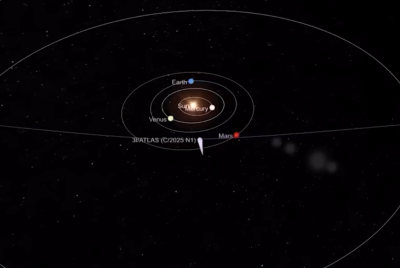Astrophotographers Are No Longer Convinced The 3I/Atlas Is Just A Comet - Here's Why
Amateur astrophotographers say 3I/ATLAS looks unlike a normal comet, showing a sharp core and uneven glow

A new wave of amateur observations of the interstellar object 3I/ATLAS has revived debate about whether it is behaving like a typical comet. Recent images shared online show a sharply defined core, uneven halo and inconsistent dust patterns that some observers say do not match standard cometary activity.
The object has attracted growing attention because of the number and clarity of amateur photographs published in recent weeks. Many of these show features that differ from the smooth, sunward-directed tails usually seen in active comets, prompting questions about how the body is shedding material as it approaches the inner Solar System.
Professional astronomers acknowledge the anomalies but continue to classify 3I/ATLAS as an interstellar comet based on spectroscopy and infrared studies. They say unusual morphology is common in objects that warm rapidly after long periods in deep space.
Amateur Images Raise New Questions
The current scrutiny began when Night Sky Now, a popular astronomy account on X, highlighted a recent livestream by Chuck's Astrophotography. The post noted that the object's core appeared sharply defined and the surrounding glow seemed patchy, with little sign of a conventional tail. The account said this appearance did not resemble a standard gas-rich comet and encouraged others to examine their own images.
Amateurs soon shared a flood of photographs. Some showed colour variations within the coma, while others reported jagged, fan-like dust outflows rather than a smooth anti-solar tail. A few contributors produced close-up stacks that appeared to show rotation within the halo. These images continue to circulate widely, although specialists caution that strong contrast stretching and noise reduction can introduce artefacts that exaggerate fine structure.
🚨 3I/ATLAS is Getting Brighter! 🚨
— Night Sky Now (@NightSkyNow) November 26, 2025
Today’s latest photo of 3I/ATLAS captured by Chuck’s Astrophotography looked completely off. The core is too sharp, the halo uneven, the glow patchy — and there’s no tail at all.
It doesn’t behave like a normal comet.#3IATLAS #spacemystery pic.twitter.com/m1ZuABgCJH
This is a close-up image of 3I/ATLAS taken yesterday by Ray's Astrophotography. I removed all of the "color", so that we could see its black-and-white structure more clearly.
— Red Collie (Dr. Horace Drew) scientist/inventor (@RedCollie1) November 27, 2025
Now we can see a clear, "clockwise spin wave" in its gaseous coma, for the first time in all studies of… pic.twitter.com/FX7Gl0pNy1
🚨 3I/ATLAS Like You’ve Never Seen Before… Something Is Very Wrong 🚨
— Astronomy Vibes (@AstronomyVibes) November 27, 2025
Ray’s Astrophotography’s latest images and footage reveal anomalies that defy everything we expect from a comet. Two perfectly straight, jet-like features shoot out from opposite sides, ignoring the Sun and… https://t.co/KL1iXLfYfi pic.twitter.com/RRiAwAEN2X
What Scientists Say About the Anomalies
Despite the online speculation, professional astronomers maintain that the strongest evidence still supports a cometary explanation. According to NASA's Goddard Space Flight Centre, early spectral readings and infrared data revealed the presence of carbon dioxide and other volatiles in the coma. Observations from both ground-based facilities and the James Webb Space Telescope indicate active outgassing, which is seen as a hallmark of genuine cometary behaviour.
Researchers accept that the balance of dust and gas in 3I/ATLAS is unusual. Some amateur spectra have shown weak emission lines, while the object's changing appearance has led to claims of uneven or fragmentary activity. Scientists say this may reflect rapid heating or structural stress as sunlight reaches fresh material on the nucleus. They add that small telescopes often capture dust more effectively than faint gas signatures, which can create misleading impressions when images are heavily processed.
🚨 🧵The New 3I/ATLAS Analysis Changes The Loeb Scale
— Skywatch Signal (@UAPWatchers) November 27, 2025
A revised Bayesian analysis just landed, and it does something nobody has done yet, it stacks all 13 of Loeb’s updated anomalies and asks one question, what are the odds this happened naturally?👇 pic.twitter.com/gO1DKaGrPy
📸 3I/ATLAS KEEPS GIVING 📸
— Drew Doss (@drew4worldruler) November 27, 2025
Just as soon as I said I was taking a day off, Satoru Murata drops this absolute dime image of 3I/ATLAS captured on 11/21 in New Mexico.
Beautiful color and clear rotation visible in the tail. The anti-tail is also clear here. What a beautiful gift… pic.twitter.com/kTr7eABHZS
@baloch1082 here.
— Mah Noor Baloch (@Baloch1082) November 28, 2025
The last 24 hrs just handed us the full picture of 3I/ATLAS.
Hubble says “normal comet.”
Amateurs say “powered craft.”
Let’s stack the receipts in one thread. 🚨🌀#3IATLAS #Exopolitics pic.twitter.com/yM6OQIOKZF
Interpreting the Developing Picture
The debate illustrates the increasingly significant role amateur astronomers play in monitoring transient objects. Their high-frequency imaging provides valuable context between professional observations, though classification ultimately relies on long-term spectroscopy and precise orbital tracking.
For now, astronomers say the most consistent interpretation is that 3I/ATLAS is an active but atypical interstellar comet whose dust-to-gas ratio and uneven jets produce the irregular structures seen in recent photographs. Both amateurs and professionals are continuing to gather data as the object moves across the sky.
Further observations from backyard telescopes and major observatories are expected to clarify whether 3I/ATLAS remains simply an unusual comet or proves to be a more exceptional visitor.
© Copyright IBTimes 2025. All rights reserved.





















